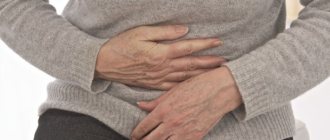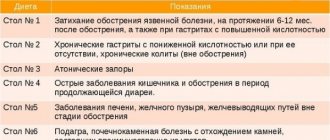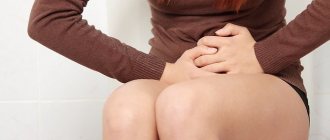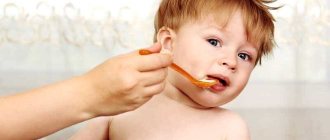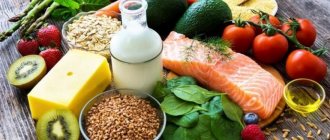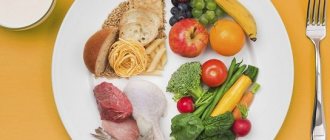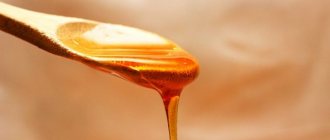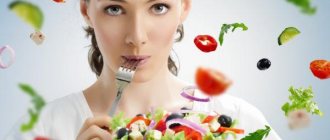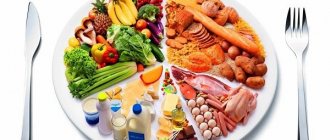Any intestinal pathology requires a radical revision of nutrition. Diverticulosis is often accompanied by stool disorders and discomfort in the abdomen, which intensify if the rules of nutrition are not followed. A diet for intestinal diverticulosis will help restore the intestinal mucosa and avoid serious complications. With such a diagnosis, it is advisable to adhere to dietary nutrition constantly and avoid breakdowns. With the help of a properly selected treatment regimen, you can quickly normalize the patient's condition.
Diet for intestinal diverticulosis: what is this disease and how can nutrition help?
Most often, this pathology occurs in people after 40-50 years of age due to degenerative processes in the intestines. Diverticula are small protrusions in the wall of an organ caused by thinning or other reasons. There may be one diverticulum or many. The danger of the disease is that it leads to:
- inflammatory process;
- intestinal bleeding;
- tumor neoplasms;
- the appearance of fistulas;
- dysbacteriosis.
Lack of treatment and poor nutrition can lead to the saddest ending - death. A diet for diverticulosis, together with drug treatment, helps normalize intestinal function. Rough, spicy food will lead to rupture of the thin wall of the diverticulum, entry of feces into the abdominal cavity, peritonitis, which is very life-threatening. However, experts say that with the right approach and timely consultation with a doctor, the disease can be cured and the risk of developing severe complications in the chronic form can be reduced.
It is important to remember that treatment in this case must be comprehensive. Medicines will not help if you eat junk food, and nutrition alone will not help quickly relieve pain and inflammation if it has spread.
Causes
It is impossible to single out one etiological factor leading to the formation of colon diverticulosis; congenital formations arise due to disturbances in the anlage of the organ during embryonic development.
The following factors are to blame for the occurrence of acquired diverticulosis:
- Genetic predisposition and family history.
- Increased pressure in the lumen of the large intestine.
- Nutritional features: low-fiber foods.
- Chronic constipation.
- Age over 50 years.
- Physical inactivity, sedentary lifestyle.
- Inflammatory processes in the intestines.
- Increased contractile activity of the muscle layer of the organ wall.
- Obesity.
The above factors can cause multiple bulging of the mucous layer and submucosa and the formation of formations resembling small sacs: they have a small neck of 3-4 mm and a body with a diameter of 5-15 mm.
As the “bags” increase in size, they become thinner, the mucous membrane atrophies, and perforation and other complications may occur.
Causes and signs of pathology
At first, the disease may resemble a common intestinal disorder. But with diverticulosis, the symptoms do not subside, but, on the contrary, increase. Signs of the disease include:
- chronic constipation;
- bloating, rumbling;
- pain in the navel area or below;
- nausea;
- the appearance of blood impurities in the stool.
If such symptoms occur, you should immediately consult a doctor, undergo an examination and begin treatment. The sooner measures are taken, the lower the risk of unpleasant consequences. Symptoms may vary depending on the course of the disease. For example, a patient may experience frequent belching and tenesmus (false urge to defecate).
Problems with blood vessels, weakening of the intestinal walls and stretching due to constipation can lead to the appearance of diverticula. Due to age-related changes in the body, the disease is difficult to avoid after the age of 50. The risk of diverticulosis increases due to poor nutrition, stress, excessively strict diets, intestinal infections, and hormonal imbalances. This disease must be treated as early as possible.
Signs, symptoms and treatment
In 70% of people, uncomplicated diverticulosis is asymptomatic, so many patients live for many years and do not even suspect that there are multiple saccular dilations in their intestines until the disease makes itself felt in the clinic by developing complications.
But in 30% of patients, even an uncomplicated disease can manifest itself with non-specific symptoms: abdominal pain, flatulence, unstable stool.
Surgeons distinguish three main clinical forms of this disease:
1. Without clinical manifestations
This form is an accidental finding detected during a clinical examination of the intestines, and comes as a surprise to the patient, since the disease does not manifest itself in any way.
2. With clinical manifestations
A non-specific clinic may be observed:
- Pains of an aching, pulling nature, often in the left iliac region, less often in other parts of the colon, intensifying during or after eating and decreasing after defecation.
- Long-term existence of abdominal pain syndrome (more than 3-4 weeks).
- Bloating, worse after eating.
- Unstable stool: alternating diarrhea and constipation. When the colon is affected, constipation is more common, but the consistency of the excreted stool is in the form of balls, mixed with mucus.
3. Complicated form
Due to stagnation of intestinal contents in the formations, an inflammatory process (diverticulitis) may develop, the wall may become thinner, and its perforation and perforation may develop.
With complications, the following clinical symptoms occur:
- Sharp, growing, unbearable pain in the abdomen.
- Bleeding from the rectum.
- Violation of intestinal motility.
- Temperature rises to high levels.
- Shock clinic: drop in blood pressure, cold sticky sweat, pale skin, loss of consciousness.
These and other complications are dangerous and life-threatening, require immediate surgical intervention and are manifested by the clinic of an acute abdomen.
Features of diet and nutrition for intestinal diverticulosis
Most often, dietary nutrition for this disease includes a large amount of fiber, protein, a minimum of salt and hot spices. If the disease has already become chronic, it is necessary to adhere to a proper healthy diet throughout your life. Any diet violations will lead to exacerbations and relapses. To create a menu for a week during a diet for intestinal diverticulosis, you need to remember the following nuances:
- You need to eat 5-6 times a day, but keep the portions small.
- Warm food is best digested, not hot or cold.
- It is advisable to prepare purees and other dishes with a soft consistency. If food is hard, it must be chewed thoroughly. The basis of nutrition should be slimy porridges, soups not based on meat broth.
- All foods that cause increased gas formation should be excluded.
- Although dietary fiber and dietary fiber are good for the intestines, rough fiber can damage the intestinal walls.
- You need to eat more dairy products. They not only help normalize digestion, but also restore intestinal microflora thanks to lacto- and bifidobacteria. However, you need to choose only low-fat foods.
- For the normal functioning of all internal organs, you need to follow a drinking regime. Pure water without gas helps relieve inflammation, get rid of constipation and improve metabolism. You need to drink 6-8 glasses of clean water per day, not counting tea and juices.
- You will have to forget about alcohol, nicotine and strong coffee. They have a particularly negative effect on the functioning of the colon.
- It is important to remember about the rules of thermal processing of food. Frying is not recommended, as it leaves no vitamins and minerals in the food, and frying in oil is harmful to digestion. It is best to choose boiling, stewing, steaming.
The doctor will be able to draw up a nutrition and treatment plan after the examination. If there are other chronic diseases, they also need to be taken into account when creating a menu.
Treatment of intestinal diverticulosis
Since it is necessary to treat diverticulosis taking into account the causes of its occurrence, the patient must be prepared to change his lifestyle, first of all, to a significant change in his diet. A special diet is the basis for the treatment of this disease, regardless of its form, since the causes of divertriculus lie mainly in poor nutrition. Additionally, medications are used, and in difficult cases, surgery.
Diet
Diet forms the basis of treatment for uncomplicated and asymptomatic diverticulosis. It is recommended to include more fiber products in the diet of patients. They increase the volume of stool and help reduce pressure in the intestines, which promotes faster and easier bowel movements. Fiber prevents further progression of diverticula, and in some cases leads to their regression.
The menu includes the following sources of fiber:
- bran bread or wholemeal bread;
- cereal porridge (wheat and buckwheat) with the addition of vegetable oil;
- vegetable casseroles or vegetables baked on a wire rack as a side dish;
- soups with meat or chicken broth and vegetables;
- dairy products.
In addition to vegetables and fruits, it is useful to include wheat bran in the menu. This should be done gradually so as not to provoke intestinal irritation. The initial daily intake is from 5 to 10 g of bran, then it is increased to 30 g.
To prevent the bran from damaging the intestinal walls, it is recommended to pour boiling water over it for half an hour and drain. You can add steamed bran to vegetable dishes, cereals, yogurt and soups.
Pasta and baked goods, semolina and rice porridge, jelly, strong coffee and tea, wine (red), and cocoa products should be excluded from the diet.
Drug therapy
With colonic diverticulosis, symptoms and drug treatment are directly related. The list of medications that are recommended for patients with this diagnosis includes:
- antispasmodics - Mebeverine, No-Shpa, Meteospasmil, Bucopan - are often used at the initial stage of therapy;
- sources of dietary fiber - Mukofalk, Solgar, Ispagol - replace bran, as they do not cause flatulence and cramps, stimulate the restoration of intestinal microflora;
- probiotics - Linex and its analogues - to restore microflora;
- prebiotics for loosening stool based on lactulose - Duphalac, Normaze and others;
- enzyme preparations are prescribed for severe digestive disorders, as well as in the presence of an inflammatory process;
- stimulants of intestinal motility - Motilium, Motilak, Domperidone;
- Broad-spectrum antibiotics are prescribed for inflammation of diverticula.
If treatment with medications does not lead to improvement, the patient is hospitalized and given infusion therapy. At the same time, additional research is being carried out and the issue of surgical intervention is being considered.
Surgery
Surgical intervention is used if diverticulosis of the descending section (or any other) worsens more than 2 times. In such situations, it is important to prevent intestinal perforation and the development of peritonitis, which often occurs with repeated attacks. For patients over the age of 40 years, elective surgical intervention is prescribed after the first exacerbation.
Also indications for the operation are:
- intestinal bleeding;
- intestinal obstruction;
- intestinal perforation;
- suppuration of the diverticulum with threatening or ruptured abscess.
During surgery, part of the intestine affected by diverticula is removed; the volume of intervention is determined individually.
The prognosis for timely diagnosed disease is favorable. More than 80% of operations are completed without subsequent complications, the risk of relapse is no more than 25%.
Diet for diverticulosis: what is possible, what is not?
To prevent the development of inflammation, suppuration and rupture of diverticula, you need to carefully review your diet.
The diet for intestinal diverticulitis in adults allows the consumption of the following products:
- mashed potatoes;
- buckwheat and oatmeal with water or half-and-half milk;
- low-fat vegetable soups;
- yesterday's or dried wheat bread (not rye);
- a small amount of butter;
- fermented milk products with a small amount of fat;
- boiled eggs (1 piece per day);
- non-acidic fruits and vegetables after heat treatment or in puree form;
- lean and uncooked meat;
- fish.
You can prepare many delicious dishes from the above. You need to add salt to a minimum, exclude seasonings with the addition of flavor enhancers. You can season dishes with dill, parsley, dried mild herbs, and lemon juice. You cannot eat store-bought sauces, mayonnaise, or ketchup. If you follow the diet, unpleasant symptoms decrease already on the 2nd day.
You can eat fresh low-fat cottage cheese and add a little cream to it. Eggs should be eaten with caution. It is better to use them less often in the form of omelettes. You can't eat scrambled eggs. For snacks, biscuits or other low-sweet and savory cookies are allowed. Marmalade in small quantities and honey will also be useful if you are not allergic to it. Soaked dried fruits can be eaten daily. However, it is important to remember that prunes in large quantities provoke a rapid cleansing of the intestines. Therefore, 10 pieces per day will be enough.
The following should be excluded from the diet for diverticulosis:
- any fried foods;
- canned food;
- fast food;
- soda;
- alcoholic drinks;
- citrus and other sour fruits;
- spicy seasonings;
- sausages;
- cabbage;
- onion and garlic;
- strong coffee.
The diet should not contain foods containing small indigestible particles, such as seeds, strawberries, popcorn, kiwi. You also need to remove too coarse fiber: radishes, turnips.
At the first signs of improvement, you should not immediately quit the diet and return to your usual lifestyle. The presence of diverticula will always create conditions for the development of the inflammatory process, so it is better to forget prohibited foods forever.
What should you not eat if you have diverticulosis?
The undesirable list of foods includes those that cause constipation and increase gas formation:
- beans, peas;
- alcohol;
- tea with milk, whole milk, jelly;
- sweets, chocolate;
- lard, fatty meats;
- mushrooms;
- semolina porridge, white flour;
- white bread and buns, cookies, cakes and pastries;
- pasta made from premium flour;
- canned food, smoked products;
- marinades, sauces;
- cabbage;
- old kefir (more than 2-3 days);
- seeds, nuts;
- chips, snacks, salted nuts;
- semi-finished products, fast food.
Diet for colon diverticulosis: sample menu
Healthy nutrition should become constant with this diagnosis. You should try to prepare dishes only from approved products. You can diversify the menu, create unusual recipes from meat, vegetables, low-fat cottage cheese. At first the menu should look like this:
- porridge or fruit salad for breakfast;
- You can have a snack with yogurt without additives or flavors;
- for lunch, vegetable soup and a slice of bread, cheesecakes made from light cottage cheese in the oven;
- afternoon snack – a glass of kefir;
- dinner - a piece of fish baked in foil with stewed vegetables.
Despite the fact that fermented milk products are allowed, you should not drink regular milk. It is difficult to digest and can cause flatulence and stool upset. You can cook porridge with milk, but choose only low-fat ones. You should not overeat at night, as this is an additional burden for the intestines. If you feel very hungry and interfere with sleep, you can drink a glass of kefir, eat a sweet fruit, or a baked apple.
For breakfast you can also eat toast with a piece of cheese or butter, cottage cheese casserole, and fruit. It is better to drink tea an hour after meals so as not to dilute gastric juice. It is also useful to drink a glass of warm water before breakfast, half an hour before meals, to start the digestive tract.
For lunch and dinner, it is acceptable to eat meat, such as chicken breast or lean beef. The meat is boiled, stewed, baked. Buckwheat, rice, and vegetables are suitable as a side dish. The meat needs to be washed well, processed, peeled, cartilage and veins removed.
When preparing soups, you cannot use bone broths, but you can add small pieces of boiled meat. Puree soups are especially useful. Dinner should be light but filling. An excellent option would be fish, vegetable stew, baked potatoes.
The diet for diverticulosis of the large intestine should exclude all foods that irritate the mucous membrane. If nausea or blood in the stool occurs during treatment, you should immediately consult a doctor. In some cases, surgery is required.
You need to follow a strict diet for 2 weeks, then you can add pasta to your diet, a small amount of sweets (cookies, marshmallows), but avoid fatty, fried and spicy foods.
Diet menu for diverticulosis of the sigmoid colon
During treatment of diverticulosis of the sigmoid colon, food is prepared by boiling, stewing, baking or steaming. Fried and smoked foods are excluded during the diet.
Nutritional therapy should be started gradually. A sudden change in diet will have an unpredictable effect on the body.
An example of a menu for one day for diverticulosis of the sigmoid colon:
- 1st meal: cottage cheese casserole, tea, preferably herbal;
- 2nd: berry cocktail with kefir;
- 3rd: porridge with milk and cheesecakes;
- 4th: kefir;
- 5th: fish stew with vegetables.
A very easy and tasty recipe for a berry-kefir cocktail: kefir - 0.5 l, strawberries - to taste, raspberries - to taste. Cut strawberries and raspberries are poured with kefir, everything is thoroughly beaten with a blender. The cocktail is ready.
Diet for diverticulitis: what to do during an exacerbation?
The diet for intestinal cyverticulosis during its exacerbation should be especially strict. Many experts recommend complete fasting and drinking plenty of fluids. During the acute period, symptoms are especially severe. The patient experiences abdominal pain, nausea, and bowel movements. The main task of nutrition at this time is to relieve inflammation, normalize organ function and restore digestion.
If the symptoms are severe, you can fast for the first day and drink more clean water. Fasting will give the organ rest and relieve it. Fasting can last up to 3 days depending on the severity of the condition. During these 3 days, you can drink rosehip decoction to make up for the lack of vitamins. Then you can switch to dietary products. You are allowed to eat any foods from the permitted list above, but do not forget to drink enough water.
Such nutrition will reduce the load on the digestive organs, speed up metabolism, improve gastric motility, and reduce the likelihood of constipation.
You should not overeat, especially if the pathology is accompanied by flatulence. After eating, you need to feel full, but not heavy in the stomach. For severe constipation, you need to add vegetable oil to your diet. Flaxseed and olive oil are especially useful. It can be taken on an empty stomach or added to vegetable salads. You cannot fry in vegetable oil; such food will do more harm than good. It is recommended to add prunes and pumpkin to the diet, exclude baked goods, and reduce the consumption of sweets.
It is useful to drink mineral water, but first you need to release the gas from it. You can also drink homemade dried fruit compotes with a little sugar.
Often, for intestinal diseases and increased gas formation, it is recommended to drink tea with mint. However, you should consult your doctor before using this product. Inflamed mucous membranes can react unpredictably to herbs.
